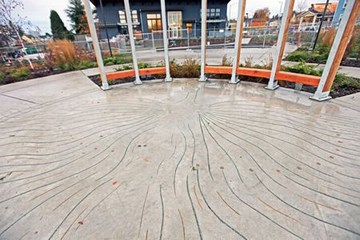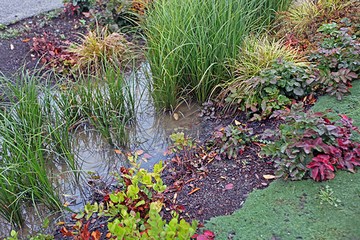Seattle Success Story: Revitalization of High Point Neighbourhood incorporates 'design with nature' approach to rainwater management

Acknowledgment: The following story is extracted from an article by Christopher Boffoli reporting for the West Seattle Blog on November 9, 2009 The extracts and two images included with this story are reproduced with the permission of Christopher Boffoli.
Historical Context
“Named for its proximity to the highest point in the City of Seattle (35th/Myrtle), the High Point neighborhood was until recently one of the districts most in need of revitalization. The area had seen many iterations over the last two centuries. By the 1990’s the neighborhood had devolved into an isolated, low-income community. Some considered it one of the most heavily concentrated pockets of poverty in King County. It gained a reputation as a scary, crime-ridden place,” writes Christopher Boffoli.
“City leaders recognized High Point as a priority that the area needed to be rejuvenated. Initial funding came in 1999. And as demolition began in earnest in 2002, plans for High Point evolved into that of a new community which, through innovative design and a recognition for the multi-cultural legacy of the neighborhood, could aspire to something more conducive to the future of the city.”
Design with Nature
“At the same time, planners articulated the need to respect the fragile natural features and beauty of High Point as well as its connection to the Longfellow Creek watershed.”
“Within the last few years these plans have come to fruition with great success, as the 120-acre High Point site has garnered international awards and acclaim for building affordable and yet environmentally sustainable housing.”
Rainwater Management
“One of the most celebrated features of the new High Point neighborhood is an elaborate drainage system which, with features like porous concrete, pollutant-filtering soil layers, plantings and an artificial pond, works to enhance rainwater management with the result of easing the pace of rainwater drainage into the Longfellow Creek watershed.”
“The new neighborhood center fits into this system like a perfect puzzle piece. The impact of rainwater falling on this building will be as if it were falling on a pasture,” Boffoli quotes Peter Wolf, who headed up the team of people responsible for raising $13 million in public and private donations to support construction of the High Point Neighbourhood Center.
To read the complete story, click on See the High Point Neighbourhood Center.

Posted November 2009

